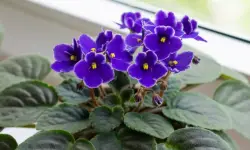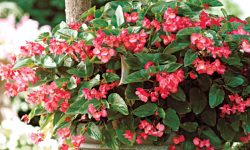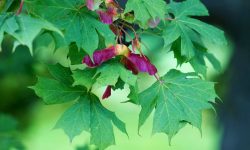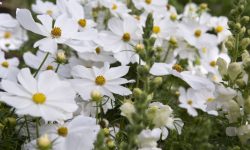You might be someone looking to shop for small Florida palm trees ideal for your tropical southern garden landscape. But due to their close similarities, it can be challenging to pick the perfect option.
My favorite types of Small Florida Palm Trees are Florida thatch palm, bottle palm, dwarf sugar palm, and Everglades palm. I wrote this article to share detailed insights on small palm trees in Florida.
Different Types of Small Florida Palm Trees
Most small palm trees in Florida do not grow more than 6m (20ft) tall. Below is a list of low-growing Florida palm trees to add a tropical twist to your garden landscape:
Madagascar Palm (Pachypodium lamerei)
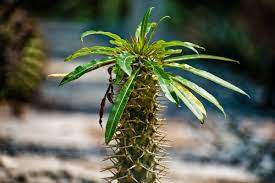
It is a unique and striking succulent plant native to the island of Madagascar. Despite its name, it is not a true palm but rather a member of the Apocynaceae family.
The small palm tree has a thick bottle-shaped trunk covered in sharp thorns and topped with a tuft of long, slender leaves. The trunk can reach heights of up to 6 to 8 feet (1.8 to 2.4 meters) in cultivation, while wild specimens can grow even taller.
During the spring and summer months, the Madagascar Palm produces beautiful, trumpet-shaped white flowers with a yellow center. These fragrant blooms add to the plant’s visual appeal. In its natural habitat, it serves as a valuable food source for pollinators such as bees and butterflies.
The Madagascar Palm is well-suited to arid and desert-like conditions, making it an excellent choice for drought-tolerant gardens or as a houseplant in dry climates. It requires ample sunlight and well-drained soil to thrive. It is important to note that this plant is toxic if ingested, so it should be kept away from children and pets.
Spindle Palm (Hyophorbe verschaffeltii)
It is a tropical palm species known for its unique spindle-shaped trunk. Native to the Mascarene Islands, specifically Mauritius and Réunion, this palm tree grows up to 10-20 feet in height and features feathery, arching fronds that can reach lengths of 8-12 feet.
The distinctive characteristic of the Spindle Palm is its swollen trunk, which tapers towards the top, resembling a spindle or bottle shape. This attribute gives the palm its common name. The trunk is typically smooth and grayish-green, with prominent ring-like markings left by the shed frond bases.
The Spindle Palm is highly prized for its ornamental value, often used in landscaping and as a focal point in gardens. It thrives in warm, tropical climates and requires well-drained soil and ample sunlight. This palm species is relatively low-maintenance, moderately drought-tolerant, and can withstand some degree of salt exposure.
Chinese Fan Palm (Livistona chinensis)
It is a popular palm tree species native to southern Japan, Taiwan, and parts of southern China. It is known for its distinctive fan-shaped leaves and graceful appearance.
The Chinese Fan Palm typically grows to a height of 30 to 50 feet (9 to 15 meters) and forms a single, slender trunk covered in a fibrous brown-gray bark.
The palm’s large, glossy, dark green leaves have deeply divided segments that radiate from the center, resembling a fan. It produces small, inconspicuous yellow flowers that give way to small, round fruits.
It is also widely cultivated in tropical and subtropical regions around the world due to its ornamental value and adaptability to different soil types and climates. It is often used in landscaping and can thrive in both full sun and partial shade.
European Fan Palm (Chamaerops humilis)
It is a small palm tree native to the Mediterranean region. It is characterized by its fan-shaped leaves and compact growth habit, reaching a height of around 10 to 15 feet (3 to 4.5 meters).
The palm’s leaves are deep green and divided into multiple segments, giving it an attractive and tropical appearance. It is a slow-growing and hardy palm that can tolerate a variety of soil conditions.
It is used as a decorative plant in gardens and landscapes since it adds a touch of elegance to outdoor spaces and indoor spaces with adequate sunlight. It produces small yellow flowers with dark blue-black fruits.
Arikury Palm (Syagrus schizophylla)
It is a species of palm tree native to Brazil and belongs to the Arecaceae family. This palm species is renowned for its distinctive and attractive appearance.
It typically grows to a moderate height, reaching around 10 to 15 meters (33 to 49 feet) tall. The trunk is slender and grayish-brown in color, marked with characteristic rings left by fallen leaf bases.
The palm produces clusters of bright orange fruits known as arikury nuts. These fruits are highly attractive to wildlife such as birds and small mammals, which play a significant role in dispersing the palm’s seeds.
The Arikury Palm is well-adapted to the harsh conditions of the Cerrado biome, characterized by a long dry season and sporadic rainfall. It can tolerate drought and prefers well-drained sandy soils. Its resilience to fires, as its apical bud is located high above the ground, protecting it from most ground fires.
The Arikury Palm is not only valued for its aesthetic appeal but also for its practical uses. The wood of this palm is utilized for construction purposes, while the leaves are often woven into baskets, mats, and hats.
Everglades Palm (Acoelorrhaphe wrightii)
It is a species of palm that is native to the Everglades region in southern Florida. It is also referred to as the Paurotis Palm. This palm species is characterized by its slender, solitary trunk that can reach heights of up to 15-20 feet (4.5-6 meters). The trunk is typically covered in persistent leaf bases, giving it a unique textured appearance.
The Everglades Palm produces a crown of large, fan-shaped leaves that are about 3-5 feet (1-1.5 meters) in diameter. These leaves are deeply divided into several segments and have a bright green color. One of the distinctive features of this palm is the diamond-shaped leaf scars that remain on the trunk after the leaves have fallen.
This palm is well-adapted to wet and swampy conditions, as it can tolerate periodic flooding and moist soils. It is often found growing in marshes, swamps, and lowland areas, including the wet prairies of the Everglades. It can also tolerate full sun to partial shade.
Dwarf Palmetto Palm (Sabal minor)
It is a small palm species native to the southeastern United States. It is primarily found in regions ranging from Texas to the Atlantic coast, including Florida. It is a popular choice for landscaping due to its compact size and adaptability to various soil types.
This palm species typically grows in clumps or clusters and reaches a height of 3-6 feet (0.9-1.8 meters). It has a short trunk that is covered in persistent leaf bases. The leaves of the Dwarf Palmetto Palm are fan-shaped and deeply divided into multiple segments, giving them a feathery appearance. The color of the leaves can vary from green to bluish-green.
The Dwarf Palmetto Palm is known for its resilience and ability to tolerate harsh conditions. It can thrive in both wet and dry soils, ranging from swamps and marshes to sandy upland areas. It is also capable of withstanding cold temperatures and is one of the most cold-hardy palm species, capable of surviving temperatures as low as 5°F (-15°C).
Silver Saw Palmetto (Serenoa repens)
It is a slow-growing palm species native to the southeastern United States, particularly in Florida. It is a small to medium-sized palm that typically grows in clumps or dense thickets.
This palm species has a prostrate or decumbent trunk that lies along the ground or grows at a slight angle. The trunk can reach lengths of up to 10 feet (3 meters) and is covered in persistent leaf bases. The leaves of the Silver Saw Palmetto are fan-shaped and can reach lengths of 3-4 feet (0.9-1.2 meters). The upper surface of the leaves is green, while the undersides have a silvery or whitish coloration, giving it its common name.
The Silver Saw Palmetto is valued for its medicinal properties. The berries of this palm have been traditionally used in herbal remedies and dietary supplements. Extracts from the berries are believed to have anti-inflammatory and anti-androgenic effects and are commonly used for the treatment of benign prostatic hyperplasia (enlarged prostate) and other urinary conditions.
Windmill Palm (Trachycarpus fortunei)
It is a palm species native to the mountainous regions of China in the provinces of Chongqing, Sichuan, and Yunnan. It is widely cultivated and has become naturalized in various parts of the world due to its ornamental value and cold tolerance.
The palm has a slender fibrous trunk that can reach heights of 30-40 feet (9-12 meters) and is covered in a dense layer of brown to grayish-brown fibers that give it a rough texture. The crown consists of large, fan-shaped leaves that are 2-3 feet (0.6-0.9 m) wide.
It can tolerate colder climates since it is the most cold-hardy palm species and can withstand temperatures as low as 5°F (-15°C) when established. This makes it a popular choice for landscaping in regions with mild winters.
Pygmy Date Palm (Phoenix roebelenii)
It is a popular palm tree native to Southeast Asia. It is a small-sized palm that typically reaches a height of 6-10 feet (1.8-3 meters). The palm has a single slender trunk that is covered in brown fibers and topped with a dense crown of feathery, arching fronds.
This palm tree is highly valued for its compact size, making it suitable for both indoor and outdoor settings. It is often used as a decorative plant in gardens, landscapes, and interior spaces. The Pygmy Date Palm is known for its adaptability and can tolerate a range of conditions. It prefers bright, indirect light but can also handle some shade.
Pindo Palm (Butia capitata)
It is also known as the Jelly Palm since it is a medium-sized palm tree native to South America. The Pindo Palm features a stout trunk that can grow up to 20-25 feet (6-7.6 meters) in height.
The trunk is covered with a fibrous, light brown to grayish-brown bark and its crown consists of blue-green, arching fronds. The fronds have a silvery-gray underside, which adds to their ornamental appeal.
It produces small, round to oval-shaped fruits that ripen to a yellow-orange color. These fruits are edible and have a sweet, tangy flavor. They are often used to make jellies, jams, and even wine.
It can tolerate a wide range of environmental conditions. It is drought-tolerant and can survive in various soil types, including sandy or clay soils. It thrives in full sun but can also tolerate partial shade. It is a popular choice for landscaping in coastal areas due to its salt tolerance.
Florida Cherry Palm (Pseudophoenix sargentii)
It is a slow-growing palm tree endemic to Florida, the Bahamas, and Cuba. It is a small to medium-sized palm that typically reaches a height of 15-25 feet (4.5-7.6 meters). The Florida Cherry Palm features a slender trunk with a diameter of about 6-8 inches (15-20 centimeters). The trunk is covered in old leaf bases and has a grayish-brown color.
The crown consists of upright, dark green fronds. The fronds are pinnate and can reach lengths of up to 6-8 feet (1.8-2.4 meters). They have a slightly drooping habit, adding to the palm’s graceful appearance. The leaflets of the fronds are narrow and pointed.
The Florida Cherry Palm gets its name from the bright red fruits it produces. The fruits are small and spherical, resembling cherries in appearance. They mature from green to red and are an attractive feature of this palm tree. But it is important to note that the fruits are not edible.
It is considered a rare palm species and is often protected in its native habitat. It requires well-drained soil to thrive and prefers full sun exposure. This palm tree is highly valued for its ornamental appeal and is commonly used in landscaping projects in its native range.
Final Thoughts From Experts
Most small Florida palm trees are an excellent choice for marking a bold statement to your garden landscape due to their beauty and resilience.
From the popular Pygmy Date Palm and European Fan Palm to the unique and eye-catching Dwarf Saw Palmetto and Silver Bismarck Palm, each type offers its own distinct characteristics and benefits.
We recommend considering size, sun exposure, soil conditions, and desired aesthetics before selecting dwarf Florida palm trees. By carefully considering these factors and consulting with local experts, you can make informed choices for successful growth and long-term enjoyment of small palm trees in their Florida gardens.
People Who Read This Also Read:


